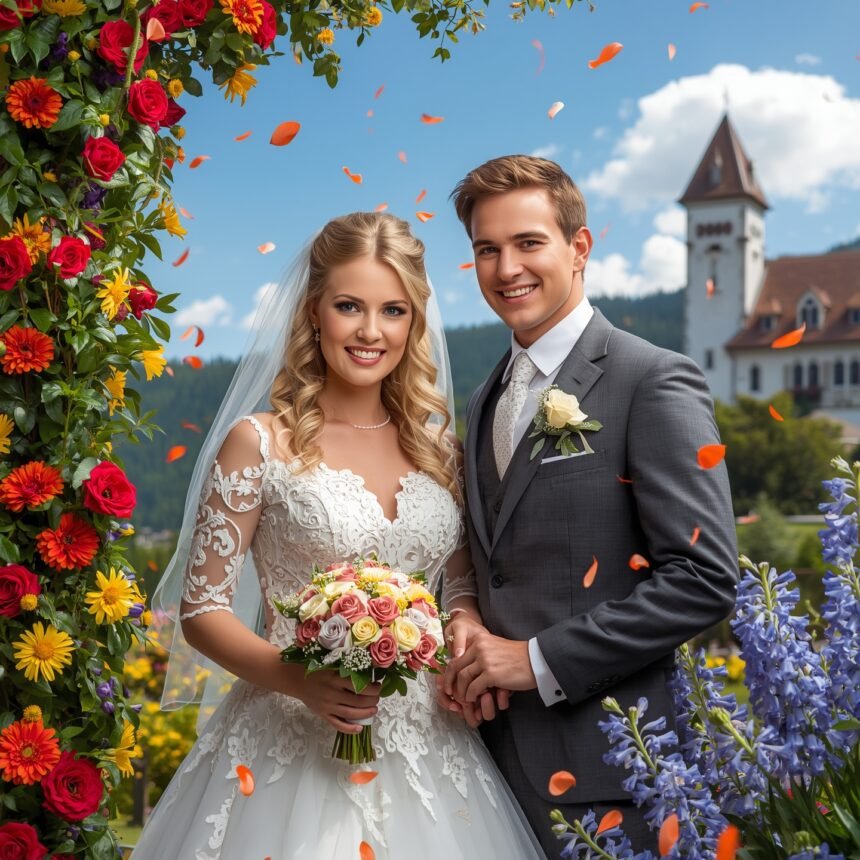German culture has always been very special in respect to flowers, as they represent love, beauty, and new beginnings. Flowers, in Germany, are not only used to embellish events; they hold a lot of substance and significance to most of the cultural practices particularly when they happen during important occasions like baptism and weddings. People present flowers not only as the guarantee of beauty and prosperity of the natural world, but also because of its hard-to-repel symbolism of life and love, family, and nature itself: a bride gilds herself with the flowers in her bouquet, a young girl with the flowers at a christening, and even a man in Germany who has died long ago is crowned with flowers upon his funeral place.
In this article, we would trace the deep German customs surrounding the use of flowers, be it in weddings, christenings, and other occasions used in different celebrations of life and how these floral customs have stood the test of time.
Weddings: The Symbolism of Flowers in German Matrimony
One of the greatest occasions in German culture is what we call weddings, and the flowers find their way in such occasions immensely. Not only are flowers viewed as a symbol of love and beauty, but it is also a sign of good luck and happy future associated with a newlywed couple. Now, we can explore the most important floral traditions that the German wedding has.
Bridal Bouquet: Love in Bloom
A bridal bouquet is the most important aspect of any wedding in Germany; it can not be regarded as a mere ornament. Close friends or family members frequently make it and not the bride. The meaning of this tradition is the encouragement of the surroundings that love the bride to begin a new life.
The flowers included in the bouquet are well chosen to convey some meanings:
- Roses The roses represent passionate figures of affection and devotion that are usually regarded as the traditional focal point of a wedding.
- Lilies symbolizes innocence and elegant looks, so it is ideal in the bouquet of the bride.
- Tulips, a spring favorite, means eternal and flawless love.
These flowers are usually used in conjunction with seasonal flowers that bloom hence on a case by case basis each wedding bouquet is a unique attribute of the season. It is also in use because white flowertowers symbolized an innocence of the bride and new life.
Flower Girl Tradition: A Symbol of Blessings
There is another favorite ritual in German weddings which is that of the flower girl; the flower girl is a young girl the most probable daughter of a family member or a good friend whose responsibility is to walk in front of the bride tossing petals on the way as she goes down the aisle. Such custom gives the ceremony a light and cheerful twist.
The petals represent good fortune to the couple in future, which brings better luck, smiling and fertility. It is a wonderful and relevant method to bring joy to the marriage of the bride and the groom and the history and interconnection of the family.
Seasonal Wedding Flowers: Reflecting the Seasons
Marriage flowers in Germany can be said to be somewhat reflective of the season. Each season is unique in its flowers and this provides a unique feel to the wedding.
- Peonies, daisies, and daffodils are commonly associated with spring weddings and are bright and reflective of newborns.
- Weddings, especially those during the summer, may be filled with sunflowers, lavender, and roses- in its prime and a symbol of joy, happiness, and beauty.
- Winter weddings are not that frequent, but even there they are not devoid of attraction. The symbolic use of holly, snowdrops and evergreens is depicted to represent perseverance and the loveliness at the lowest times of year.
These seasonal selections add a sense of harmony with nature and a personal unique touch to the wedding flowers as they dictate the time of the year.
Christenings: Welcoming New Life with Flowers
Christenings in Germany are preceded as renowned as weddings, and a child is initiated into the world and the spiritual community of his or her family. As in the wedding, there is an important use of flowers in the ceremony, symbolizing purity, a new life, and blessings.
Decorating the Altar and Gown
White dainty flowers are also common on the church altar and the outfit of the baby during a christening. Such flowers are generally white lilies, roses, or baby’s breath, and a symbol of purity and innocence. The brevity and promotion of tranquility of these flowers respond to the holiness of a christening ritual.
The ceremony also integrates the baby in most instances being carried with a small handpicked bouquet of flowers. These are not the bigger or grandiose incarnations of a wedding bouquet but they remain an essential element of the party and a symbol of the blessings the family wishes the child would receive in their future.
Floral Gifts from Godparents
There is a special and most special ceremony with regard to the godparents at German christenings. They also customarily give a flowered present to the baby. This is a symbolic activity that means a spiritual dedication to the health and beliefs of the child. Flowers presented have a certain meaning:
- Lilies for purity and virtue.
- Violets for faithfulness.
- Roses for love and promise.
They are given in the hope that the child will become a well-rounded individual in matters of faith, love, and happiness and that the guiding hand of his godparents will keep him or her.
The Flower Crown: A Symbol of Innocence and Joy
During some of the christenings of Germany , the baby is crowned with a lot of delicate and beautiful flowers, or Blumenkranz. It is a practice that prominently connects to his traditional practice of wearing flower crowns on traditional holidays such as Walpurgisnacht (when spring is coming). Even though the flower crown during a christening is not as much as in a wedding, it represents the bond between the child and nature. It is a means of signing hopes to the child of a beautiful, healthy, and well-integrating life in the surrounding world.
Flowers in German Homes: A Celebration of Everyday Life
In Germany, flowers are not exclusively used during weddings and christenings, they are also considered a normal aspect of the lives. German homes are known to have fresh flowers, having the symbolism of the joy and beauty of everyday moments.
- Everyday Gifts:
A gift of flowers at birthdays, anniversaries, or in general gratitude is not a modern trend in Germany.
- Seasonal Decorations:
Floral arrangements are done in the houses in seasons such as Christmas and Easter to mark the seasons. Christmas features poinsettias whereas spring flowers such as the hyacinths and tulips help to revive the home during Easter.
- Table Decorations:
Fresh flowers are very common in dining tables to tropicalize any meal as a celebration.
Wrapping It Up,
The use of flowers in Germany is much more than mere ornamentation; their bestowal has a profound history of meaning and symbolism, connoting love, purity, hope, and the happiness of a new start. These customs are transmitted across generations and help enrich the most immensely special parts of life.
Be it a bride and her finer bouquet, a baby on his first crown of flowers or a family sitting together with flowers of the new season, the presence of flowers will always continue to play a central role in the German festivities.
With all the world around us continually evolving, the simplicity of such floral customs is a reminder of the when and how we connect to t
he earth, one another and to the phases in our lives.









